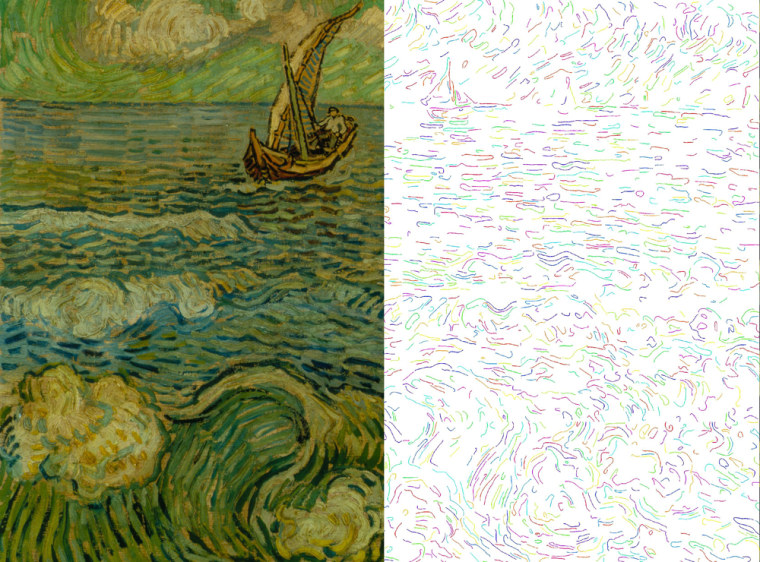Vincent van Gogh's masterpieces have inspired both young artists and prospective forgers seeking to recreate his vivid landscapes and portraits.
Those forgeries are inspirations, too. But in an ironic twist, scientists are turning to modern technology to give art experts better tools to answer an expensive and age-old question: Is it an original van Gogh painting or a fake?
A unique collaboration of artists and scientists forged by Cornell University professor C. Richard Johnson uses computer screens as canvases. While the project focuses on van Gogh's classics, the outcome could have an impact throughout the art world.
"It's something we would all like to be using a lot more, but it's really just starting," Ella Hendricks, head of conservation at the Van Gogh Museum in Amsterdam, the Netherlands, said in a recent telephone interview.
Talk of computer programs and algorithms typically aren't the forte of artists more comfortable speaking about brushstrokes and light. Johnson sought to bridge the divide. His background afforded him credibility in both fields: a Cornell electrical engineering professor who also has a minor in art history.
Johnson got curious three years ago during a sabbatical about projects that might finally marry his two interests. He found other researchers around the world working on similar projects, then approached the Van Gogh Museum with a unique proposal.
Would they allow them access to their digitized collection, so that the scientists could experiment with ways to use technology to help art historians, conservators and connoisseurs?
"I felt like maybe I could talk to both sides," Johnson said in an interview from his office in Ithaca, New York. "Certainly, in a museum, you'd like to be on the forefront of new activity, and computer imaging would be at the forefront of what to do."
The museum agreed. Hendricks and other experts there had only recently started scanning its work and dabbling in digital techniques, which in recent years has gained in popularity across the industry.
A May 2007 workshop on computer image processing at the Amsterdam museum yielded promising results, according to Johnson, with teams from Penn State, Princeton University and Maastricht University in the Netherlands each taking different approaches.
Scientists studied 101 high-resolution scans of van Gogh paintings provided by the Van Gogh and Kroller-Muller Museums in the Netherlands, of which 23 had been identified by art historians as authentic works by van Gogh.
A release from Penn State promoting results of the work published in the July issue of IEEE Signal Processing outlined the rest of the process:
The 23 authentic van Gogh paintings were used by a computer system as a training database for van Gogh's brushstroke styles. Statistical models were created to capture the unique style, or "handwriting" that became the artist's signature in those scans.
Detailed images could be blown up in size, allowing researchers to analyze intricacies of brushstrokes.
The other 78 paintings, which were composed of works of van Gogh or van Gogh's peers, or paintings at one time attributed to him but later deemed inauthentic — were compared with the statistical models generated by the 23 authentic paintings.
Penn State information sciences professor James Wang and statistics professor Jia Li compiled the findings into an online system that can be used to help sort out discrepancies between authentic and forged paintings. They found that copies tend to have more brush strokes.
"Now I come along as a copyist. I can't do (the original) in one motion because I'm not (van Gogh)," Johnson said. "So I strike the brush multiple times to mimic the art."
It's a painstaking process that could go unnoticed to the naked eye.
But Johnson sees the project as an added tool — rather than a replacement — for art experts.
"I guess the easiest way to think about it is you're a detective at a murder scene. You got to collect a lot of evidence but you don't really know which piece of evidence is the one that cracks it open for you," Johnson said. "That's the job, so to speak, of the conservators of the museum."
"They try to add a whole bunch of other evidence and try to make a decision about authentication."
Many experts in the field already view the technology as more than just a tool for detecting forgeries. A second round of analysis involving more researchers is under way looking at techniques such as analyzing the thread count on a painting's canvas.
Dave Coddington, chief conservator for The Museum of Modern Art in New York, hopes digital imaging analysis helps with conservation efforts and gives students a better understanding of a painter's style.
"We're trying to understand the kind of creative process that the artist engaged in," Coddington said. "We're in the early days of what I'm expecting to be an important area for researchers."
